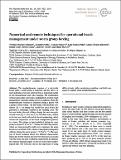Por favor, use este identificador para citar o enlazar a este item:
http://hdl.handle.net/10261/174773COMPARTIR / EXPORTAR:
 SHARE SHARE
 CORE
BASE CORE
BASE
|
|
| Visualizar otros formatos: MARC | Dublin Core | RDF | ORE | MODS | METS | DIDL | DATACITE | |

| Título: | Numerical and remote techniques for operational beach management under storm group forcing |
Autor: | Morales Márquez, Verónica CSIC ORCID; Orfila, Alejandro CSIC ORCID ; Simarro, Gonzalo CSIC ORCID ; Gómez-Pujol, Lluís CSIC ORCID; Álvarez-Ellacuria, Amaya CSIC; Conti, Daniel CSIC; Osorio, Andrés F.; Marcos, Marta CSIC ORCID | Fecha de publicación: | dic-2018 | Editor: | European Geosciences Union | Citación: | Natural Hazards and Earth System Sciences 18(12): 3211-3223 (2018) | Resumen: | The morphodynamic response of a microtidal beach under a storm group is analyzed, and the effects of each individual event are inferred from a numerical model, in situ measurements and video imaging. The combination of these approaches represents a multiplatform tool for beach management, especially during adverse conditions. Here, the morphodynamic response is examined during a period with a group of three storms. The first storm, with moderate conditions (H ∼ 1m during 6 h), eroded the aerial beach and generated a submerged sandbar in the breaking zone. The bar was further directed offshore during the more energetic second event (H = 3.5m and 53 h). The third storm, similar to the first one, hardly affected the beach morphology, which stresses the importance of the beach configuration previous to a storm. The volume of sand mobilized during the storm group is around 17.65mm. During the following months, which are characterized by mild wave conditions, the aerial beach recovered half of the volume of sand that is transported offshore during the storm group (∼ 9.27mm). The analysis of beach evolution shows two different characteristic timescales for the erosion and recovery processes associated with the storm and mild conditions, respectively. In addition, the response depends largely on the previous beach morphological state. The work also stresses the importance of using different tools (video monitoring, modeling, and field campaign) to analyze beach morphodynamics | Descripción: | 13 pages, 10 figures, 2 tables.-- All data are accessible from http://apps.socib.es/beamon/ (Beach monitoring facility, 2018) and http://thredds.socib.es/thredds/catalog/mooring/waves_recorder/mobims_playadepalma/L1/2014/catalog.html (SOCIB Data centre, 2018) | Versión del editor: | https://doi.org/10.5194/nhess-18-3211-2018 | URI: | http://hdl.handle.net/10261/174773 | DOI: | 10.5194/nhess-18-3211-2018 | Identificadores: | issn: 1561-8633 e-issn: 1684-9981 |
| Aparece en las colecciones: | (ICM) Artículos (IMEDEA) Artículos |
Ficheros en este ítem:
| Fichero | Descripción | Tamaño | Formato | |
|---|---|---|---|---|
| Morales_Marquez_et_al_2018.pdf | 896,28 kB | Adobe PDF |  Visualizar/Abrir |
CORE Recommender
SCOPUSTM
Citations
23
checked on 22-abr-2024
WEB OF SCIENCETM
Citations
21
checked on 25-feb-2024
Page view(s)
324
checked on 24-abr-2024
Download(s)
216
checked on 24-abr-2024
Google ScholarTM
Check
Altmetric
Altmetric
Este item está licenciado bajo una Licencia Creative Commons

